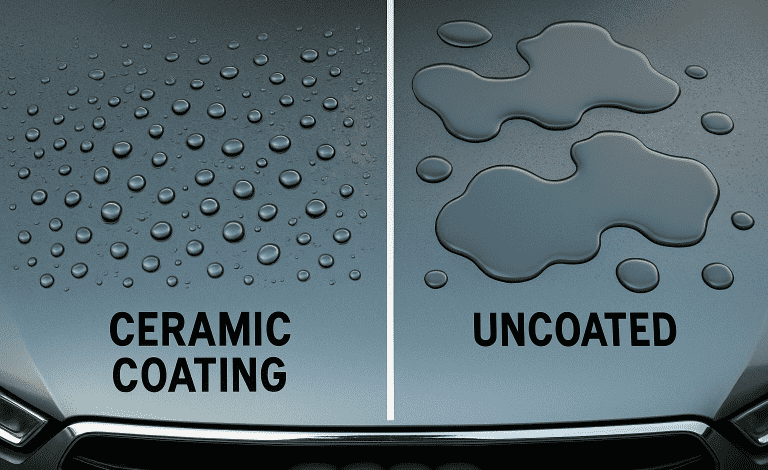Ceramic Coating Longevity: Marketing Claims vs. Reality

What Is Ceramic Coating?
Ceramic coating is a scientifically engineered liquid polymer applied to the exterior of vehicles to create a semi-permanent protective layer. Its nanoparticles bond with the factory paint, resulting in a surface that repels water, resists minor scratches, and prevents contaminants from embedding. Unlike traditional waxes and sealants, ceramic coatings offer longer-lasting protection and a more durable hydrophobic effect. For vehicle owners seeking top-tier protection, ceramic coating for cars in Tyrone, GA is quickly becoming a go-to solution.
While waxes typically last a few weeks and sealants a few months, ceramic coatings can endure for years under the right conditions. The comparison often centers around longevity, depth of gloss, and ease of maintenance—areas where ceramic outperforms many conventional products. However, these advantages have created much marketing buzz, and not all claims hold up to real-world scrutiny.
The Rise of Ceramic Coating in Auto Care
Over the past decade, ceramic coating has stormed into the mainstream of automotive care, quickly outshining traditional detailing products. This surge is fueled by advances in nanotechnology, social media hype, and viral “water beading” videos. Many drivers search for automotive ceramic coating near me to find trusted professionals who can deliver these results, protecting their investment and reducing maintenance hassles.
With manufacturers promising multi-year protection, superior gloss, total UV resistance, and enhanced chemical shielding, it’s no wonder that demand outpaces most new car care technologies. Yet, as with most products experiencing rapid adoption, complexities around the reality of performance often emerge—making it crucial to separate facts from advertising claims.
Marketing Claims vs. What Science Says
Manufacturers often claim their ceramic coatings provide near-invincible protection—some even suggest a single application lasts forever. The most common assertions include years-long durability, scratch-proof finishes, effortless cleaning, and total immunity against UV and chemical damage. However, independent lab results and real-world use cases reveal a more nuanced picture.
While ceramic coatings resist surface contaminants, make cleaning easier, and protect against certain chemicals, independent testing frequently refutes the “scratch-proof” myth. In reality, they are scratch-resistant, not scratch-proof. Some studies have also shown that longevity greatly depends on climate and upkeep, not just initial application.
Factors Affecting Ceramic Coating Longevity
Several factors play a role in how long ceramic coatings truly last. The environment tops the list—vehicles exposed to harsh sunlight, salty winter roads, and industrial pollutants experience faster degradation. Driving habits also matter: frequent off-roading or high-mileage commutes can wear out protective layers more quickly.
Application quality is just as critical. Professional installations outperform DIY jobs because of precise surface prep and controlled environments. Even the highest-quality product won’t deliver advertised results if it’s poorly applied. Following proper procedures ensures maximum bond and long-term effectiveness.
Maintenance: The Make-or-Break Element
One of the biggest misconceptions about ceramic coatings is the belief that they’re completely maintenance-free. While it’s true that coated surfaces are easier to clean, they still require routine washing using the right products and methods. Regular contact washes, avoidance of abrasive cleaners, and occasional application of ceramic “boosters” are recommended to sustain performance.
Ignoring maintenance can lead to premature breakdown and a diminished hydrophobic effect, compromising both protection and appearance. Understanding these needs helps owners set realistic expectations and maximize their coating’s lifespan.
Signs Your Ceramic Coating Is Failing
Over time, even the best ceramic coatings will show signs of wear. Common visual cues include reduced water beading, decreased gloss, and increased accumulation of dirt or contaminants that previously washed off easily. A simple water sheeting test—pouring water on the surface and observing its behavior—can reveal if the hydrophobic effect is waning.
When these symptoms appear, it may be time to consult a professional for inspection or reapplication. Neglecting to address failing coatings can leave your paint exposed to the elements and accelerate fading or oxidation.
Cost vs. Value: Are Long-Term Benefits Real?
Ceramic coatings require a significant initial investment compared to traditional waxes and sealants. However, advocates argue the long-term value comes from less frequent detailing, reduced need for touch-ups, and potentially higher resale value due to superior appearance. Real-world experiences differ, but many vehicle owners report measurable benefits, particularly when proper maintenance is practiced.
What Vehicle Owners Need to Know Before Committing
Before investing in ceramic coating, it’s important to clarify expectations and ask potential providers detailed questions: What specific benefits can you realistically expect? How often is maintenance required? What kind of warranty is included, and what does it cover? Understanding these key points ensures no surprises and helps you make a confident decision.
Assess your driving and maintenance habits, climate, and how long you plan to keep the vehicle to determine if the investment aligns with your needs. Reputable installers should be transparent about results and ongoing care.
Separating Hype from Help
Ceramic coatings offer robust protection for vehicle paint, but no solution is truly set-and-forget. Longevity depends on careful application, regular maintenance, and transparency from providers. If you want to enhance your vehicle’s durability, gloss, and value, focus on credible service providers, be wary of overblown promises, and commit to proper care after application.
By understanding the marketing claims and scientific realities, you can confidently choose the best protection strategy for your automotive investment.



